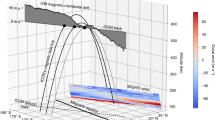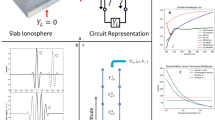Abstract
IT has been suggested recently1 that the drift of ionization in the F2 region of the ionosphere, known to exist from measurements made at middle latitudes2, is caused directly by the electric field associated with the S system of currents in the ‘dynamo’ region of the atmosphere. The presence of these currents was originally invoked to explain the daily variations in the geomagnetic elements; recent ionospheric analysis3,4 and direct experiments using rockets have shown that this dynamo region corresponds in height with the ionospheric E region. According to Martyn, magnetic lines of force linking the E and F regions represent directions of high electric conductivity and can be considered as equipotentials. Thus a horizontal north–south electric field in the E region can give rise to a vertical component of electric field in the F2 region which is greatest at the magnetic equator, where it may exceed by several times the horizontal E region field. If this field exists it must give rise to a horizontal drift of ionization in the F region in an east–west direction. Martyn5 has proposed on theoretical grounds that, except in the immediate vicinity of the magnetic equator, the eastward drift velocity resulting from the diurnal potential in the dynamo region should be given approximately by  where θ is the geomagnetic co-latitude of the point in the F region, ϕ is longitude measured positively eastward from the midnight meridian and H is the vertical geomagnetic field component. This equation predicts for high and middle latitudes a drift toward the east by day and to the west by night, which is in agreement with observations. At geomagnetic latitudes less than 35°, however, a phase reversal of this drift should take place, and near the magnetic equator the westward drift by day should reach large values of the order of 200 m./sec.
where θ is the geomagnetic co-latitude of the point in the F region, ϕ is longitude measured positively eastward from the midnight meridian and H is the vertical geomagnetic field component. This equation predicts for high and middle latitudes a drift toward the east by day and to the west by night, which is in agreement with observations. At geomagnetic latitudes less than 35°, however, a phase reversal of this drift should take place, and near the magnetic equator the westward drift by day should reach large values of the order of 200 m./sec.
This is a preview of subscription content, access via your institution
Access options
Subscribe to this journal
Receive 51 print issues and online access
$199.00 per year
only $3.90 per issue
Buy this article
- Purchase on Springer Link
- Instant access to full article PDF
Prices may be subject to local taxes which are calculated during checkout
Similar content being viewed by others
References
Martyn, D. F., Report on the Physics of the Ionosphere, 165 (Physical Society, London, 1955).
Briggs, B. H., and Spencer, M., “Rep. Progr. Phys.”, 17, 245 (Physical Society, London, 1954).
Appleton, E. V., et al., Nature, 176, 897 (1955).
Beynon, W. J. G., and Brown, G. M., Nature, 177, 583 (1956).
Martyn, D. F., Report on the Physics of the Ionosphere, 164 (Physical Society, London, 1955).
Mitra, S. N., Proc. Inst. Elect. Eng., Pt. 3, 96, 441 (1949).
Ratcliffe, J. A., J. Atmos. Terr. Phys., 5, 173 (1954).
Author information
Authors and Affiliations
Rights and permissions
About this article
Cite this article
PURSLOW, B. Ionospheric Drift in the F2 Region near the Magnetic Equator. Nature 181, 35–36 (1958). https://doi.org/10.1038/181035a0
Issue Date:
DOI: https://doi.org/10.1038/181035a0
This article is cited by
-
Equatorial Ionospheric Drifts
Nature (1966)
-
Possibility of detecting Ionospheric Drifts from the Occurrence of Spread F Echoes at Low Latitudes
Nature (1960)
-
Horizontal Drift Measurements in the Ionosphere near the Equator
Nature (1958)
-
Horizontal Ionospheric Drifts in the F2-Region at Equatorial Latitudes
Nature (1958)
Comments
By submitting a comment you agree to abide by our Terms and Community Guidelines. If you find something abusive or that does not comply with our terms or guidelines please flag it as inappropriate.



